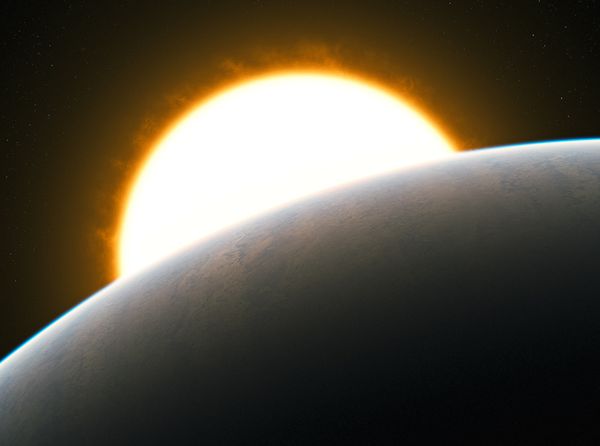
© L. Calçada/ESOThe exoplanet HD209458b orbits around its host star in an artist's impression.
A never-before-seen global superstorm has been spotted on a planet outside our solar system, a new study says.
Record-breaking supersonic winds are blasting through the atmosphere of the hot gas giant HD209458b, which orbits a distant star.
By studying the "fingerprints" of carbon monoxide gases racing between the planet's day and night sides, astronomers are getting a rare glimpse into the storm.
"We were shocked to find that the resulting pressure and temperatures differences between the hotter light side and cooler dark side triggers such fierce winds," said study leader Ignas Snellen, an astronomer at Leiden Observatory in the Netherlands.
"Incredibly this tempest encompasses the entire planet, blowing at speeds of 5,000 to 10,000 kilometers [about 3,100 miles to 6,200 miles] per hour."
Hot and Cold ExoplanetThe exoplanet orbits a sunlike star about 150 light-years away in the constellation Pegasus.
The planet, first detected in 1999, orbits only about 4.4 million miles (7 million kilometers) from its home star, which is about one-twentieth the distance between Earth and our sun.
One side of the gas giant is eternally locked toward its sun, which creates scorching temperatures of 1,800 degrees Fahrenheit (982 degrees Celsius) on its day side and much cooler temperatures on its night side.
As seen from Earth, the hot Jupiter passes directly in front of its star, taking about three hours to transit on a 3.5-day orbit.
Doppler Effect Seen on Stormy ExoplanetIn their new research, Snellen and his team discovered that when the planet passes in front of its star, a distinctive Doppler effect is visible in the starlight.
Astronomers determine Doppler effects by using electromagnetic wavelengths to figure out how quickly cosmic bodies such as stars move toward or away from Earth.
Some of that starlight also filters through the exoplanet's atmosphere, leaving behind a fingerprint of carbon monoxide gases, according to the study published tomorrow in the journal
Nature.
As a result astronomers were able to directly measure carbon levels in the atmosphere of the exoplanet.
"It seems that H209458b has about as much carbon as our Jupiter, which may indicate they share a similar evolutionary past," Snellen said.
Using an exquisitely sensitive spectrograph connected to the Very Large Telescope (VLT) in Chile, the astronomers also unexpectedly detected a Doppler shift in the carbon monoxide gas. This hints that the gas is blowing rapidly across the planet's atmosphere.
"We figured there was more information embedded inside the observed Doppler effect that can only be explained by the movement of these gases," Snellen said.
"For the first time we can directly measure not just the levels, but the movements of atmospheric gases and see superwinds blowing on an extrasolar planet."
"Exciting New Technique" Used in Storm StudyUsing the Doppler effect to show movements of gases is a "very exciting new technique for studying exoplanet atmospheres," said Sara Seager, a planetary scientist at the Massachusetts Institute of Technology.
For instance, the technique offers "new information not previously accessible: That there are likely winds, and that the winds are faster than the speed of sound," said Seager, who is not involved in the research.
But Seager cautioned that more detailed observations are needed to confirm the extent of these winds in the planet's upper atmosphere and their actual velocities.
The discovery also could boost astronomers' work in detecting environmental conditions on other exoplanets, she noted.
"The abundances of molecules and wind speeds on a number of different hot Jupiter planets," she said, "will really advance the field of exoplanet-atmosphere research."
Reader Comments
to our Newsletter